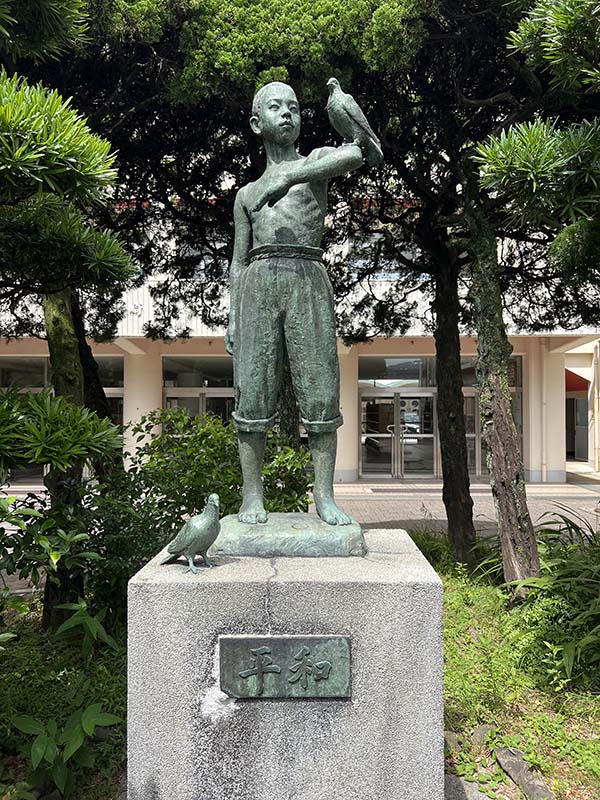Young people are an important part of nuclear weapons’ history. But despite their significant presence, historical records and scholarly research have paid scant attention to youth participation in nuclear politics. In this ‘third nuclear age’, Franco Castro Escobar argues there is a growing need to record and understand the voices of young antinuclear organisers in the twenty-first century
At the start of the first nuclear age (1945–1990), US nuclear bombings of Hiroshima and Nagasaki killed more than 38,000 children. Extensive efforts to preserve children’s experiences of nuclear harm in Japan allow us to derive an approximate figure.
The Children’s Peace Memorial profiles 431 young victims. Some died the day they were born; others in the womb. Survivors – including those who survived in utero – became known as hibakusha.
During wars, young people negotiate adult expectations while pursuing their own needs and desires. The use and testing of nuclear weapons and the threat of nuclear war affect children disproportionally. Indeed, during World War II, the young became 'the single most marginalised group'.
Children have thinner skin, which burns quicker. They are less able to escape from collapsed or burning structures. Cells that divide and grow faster become tissue later in life which is vulnerable to radiation-induced illness such as leukaemia. A 2024 report reveals that child nuclear victims live with lifelong trauma, health problems, and discrimination. They may be orphaned, homeless, displaced, and lack access to services and compensation.
Animated films including Barefoot Gen and In This Corner of the World help remember young victims from a children's perspective. Exhibits in educational institutions like Honkawa National, Shiroyama, and Yamazato also bear witness through young people’s eyes. But communities harmed by more than 2,000 Cold War nuclear tests, unaccounted accidents, and other nuclear technologies have received far less attention. Global hibakusha still struggle to record, archive, commemorate, and educate audiences about the nuclear legacies affecting them around the world.
But victimhood is not inevitable for the young. After all, most crew on the Enola Gay and Bockscar which dropped the nuclear bombs were still in their twenties, including twenty-year-old Richard Nelson. Young people have been killed by nuclear weapons, they have perpetrated the killing, and they have protested against it.
Historians have focused mostly on prominent figures leading the struggle against the bomb. But young people have made significant contributions to the global nuclear disarmament movement.
During the Cold War, 300,000 baby teeth donors provided scientific evidence of Strontium-90 contamination caused by atmospheric nuclear testing. Young activist Garry Davis renounced his American citizenship, proclaiming himself a citizen of the world, and issuing world-citizen passports. This mobilised hundreds of thousands to join the antinuclear cause. The Campaign for Nuclear Disarmament was renowned for its youthful membership, marches, and direct-action tactics.
During World War II, the top-secret Manhattan Project resulted in the creation of the first atomic bombs. Even the children of those who worked on the Project eventually joined antinuclear groups, having inherited conflicting feelings of pride, doubt, and a search for forgiveness rooted, as one of those children put it, in a 'guilt that was not mine'.
Founded in 1948, Zengakuren is a student organisation in Japan known for its activism in protest movements. It claimed to represent over 350,000 students from more than 200 universities. Although Zengakuren eventually earned a reputation for being radical and violent, it organised well-attended antinuclear boycotts and rallies.
Today, people send approximately 10 million origami cranes annually to Hiroshima’s Children’s Peace Monument.
Sadako Sasaki was two years old when the bombs dropped on Hiroshima. She lived for another ten years, with severe radiation sickness, and became one of the best-known hibakusha. Sasaki's classmates started a youth-led project in her memory.
These few examples glimpse the diversity of youth activism and politics that took place during the first nuclear age. Yet since the Cold War, nuclear disarmament groups have shrunk in size, funding, and public salience — a sign that we are forgetting.

The Peace Statue of a Boy at Shiroyama Elementary School, Nagasaki, is 500 metres from the atomic bomb’s hypocentre, where more than 1,400 students and teachers were killed.
Depicting a young boy who lost his family, it symbolises children's 'rising up to fight for ever lasting peace'.
Young atomic bomb survivor Taeko Sugawara inscribed the word 平和 Heiwa (Peace) on the plinth.
Author's photo, 23 July 2024
When the Soviet Union fell in 1991, a second nuclear age began, marked by concerns of nuclear terrorism and proliferation. Since 2019, rapidly growing nuclear perils have precipitated a third nuclear age.
Although some scholars debate how useful it is to label periods ‘nuclear ages’, research into youth antinuclear activism during these two periods remains scant. In the twenty-first century, only a small minority of people take part in antinuclear activism.
At the time of writing, there is no comprehensive study of why and how young people join or create antinuclear organisations in these two recent nuclear ages. Why have new youth-based organisations been founded? Who led their foundation? How do they organise in comparison with previous decades of activism? And why do these organisations make ‘youth’ a central component of their organisational identity?
These questions remain largely unaddressed in social movement and youth studies’ literatures. The answers to them lie also in the study of memory, intergenerational justice, and international relations. As hibakusha pass away, AI and new technologies may revolutionise human interactions with memory, and our relationships with the past.
My research will document and archive 42 oral history interviews conducted in Japan and Canada with youth antinuclear activists while they are still young and at a time when youth movements are becoming a growing feature of modern history. Keele University’s online repository will publish my research at the conclusion of my doctoral studies.
The study of antinuclear youth is crucial to understanding the nuclear politics of the twenty-first century. It is an unfolding, uncharted, and increasingly consequential territory.